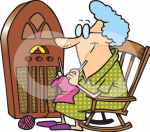Early
Developments
Advancements
in wireless communication technology here in Australia kept pace with those being made in the rest of the world.
In August 1920, at the Royal Society’s House,
Sydney, a demonstration was given for the first time of wireless telephony. Later in the same year, a two hour concert program
was broadcast at the Queen’s Hall, Melbourne.
In 192l, AWA started weekly broadcast transmissions
of gramophone records from their Melbourne offices each Monday night and reception was observed throughout the country. These
broadcasts have been claimed to be the first regular programs in the world.
In 1921, Charles McClure, of Strathfield, NSW, was
one of the first recipients of a transmitting licence, and broadcast musical programs in the Sydney area on a frequency of
about 1400 kHz. It should be noted that it was not until 1920 that permits were made available for the reception of wireless
telegraphy transmissions and only under very special circumstances would transmitting licences be issued. This of course,
had been a bitter disappointment to the many experimenters who had been carrying out wireless tests prior to the outbreak
of WW1. However, many Clubs and Associations were formed at around 1920 for receiving purposes, and it was not until July 1922 that experimenters were successful in gaining general Licence approval.
The announcement of a General Licence by the Prime Minister Mr Hughes was followed
by wholesale activity by experimenters everywhere in the country, with both private individuals and commercial enterprises
taking out licences.
In 1925, the "sealed set" System was introduced in
August, following a conference of interested parties. Under this system, wireless receivers were sealed to respond to the
wavelength of one station only, and the licensee paid a listening fee direct to the Station owner.
The first commercial licences
were issued in November 1923 to broadcasters Sydney Limited (2SB) and another to Farmer and Company
(2FC) on December 5, 1923. Their audiences were generally made up of enthusiasts and experimenters.
In 1924, other stations commenced
operations in Australia on mediumwave, and the next five years or so would see a very rapid advancement in mediumwave broadcasters,
leading to the establishment of many stations throughout the Commonwealth.

